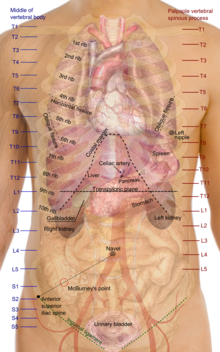
Surface anatomy (also called superficial anatomy and visual anatomy) is the study of the external features of the body of an animal.[1] In birds, this is termed topography. Surface anatomy deals with anatomical features that can be studied by sight, without dissection. As such, it is a branch of gross anatomy, along with endoscopic and radiological anatomy.[2] Surface anatomy is a descriptive science.[3] In particular, in the case of human surface anatomy, these are the form and proportions of the human body and the surface landmarks which correspond to deeper structures hidden from view, both in static pose and in motion.
In addition, the science of surface anatomy includes the theories and systems of body proportions and related artistic canons.[citation needed] The study of surface anatomy is the basis for depicting the human body in classical art.
Some pseudo-sciences such as physiognomy, phrenology and palmistry rely on surface anatomy.
- ^ Seeley (2003) chap.1 p.2
- ^ Standring (2008) Introduction, Anatomical nomenclature, p.2
- ^ "Journal of Morphology and Anatomy Surface Anatomy". Hilaris. Retrieved 1 June 2021.